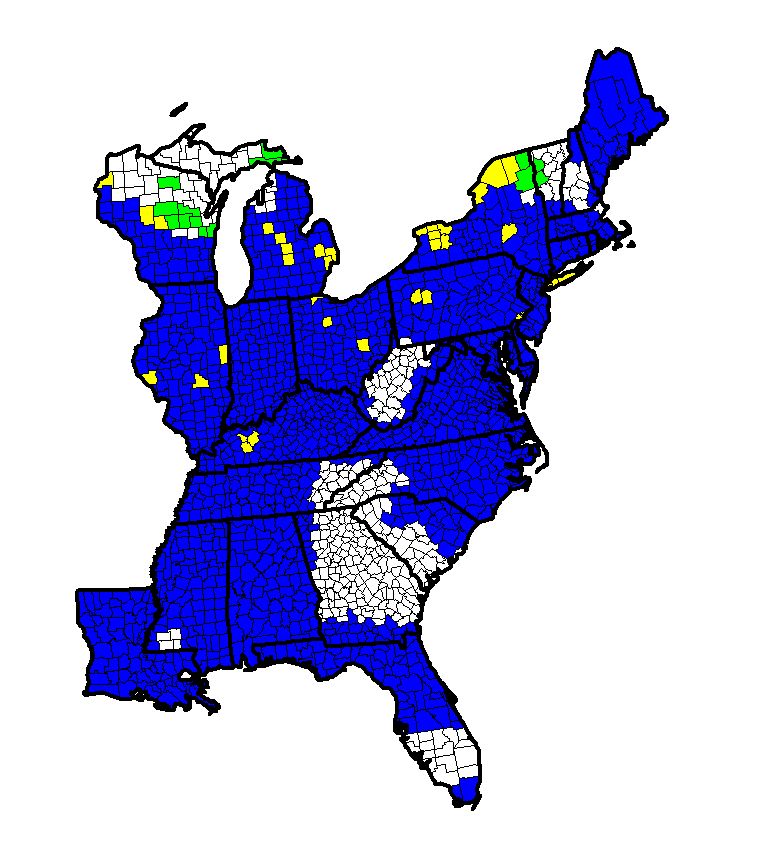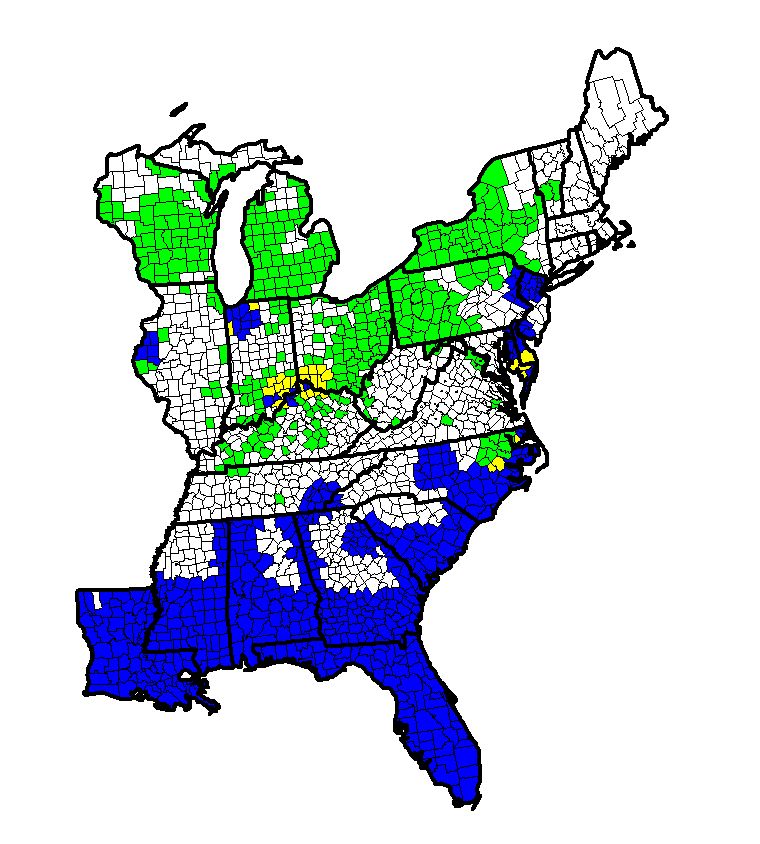The Center for Native Grasslands Management has undertaken a number of research initiatives focused on several key areas including biofuels, forage production, oak ecosystems, wildlife responses, and management of existing native grass stands.
Evaluation of Eastern Gamagrass and a Sorghum × Sudangrass for Summer Pasture
In the tall fescue belt, there is a well-known “summer slump” in forage production. This is because tall fescue, a cool-season grass, is less productive during summer. Warm-season grasses are needed that can fill this slump. One possibility is eastern gamagrass (EG), a highly productive warm-season perennial. In a four-year trial conducted at the Blount Unit of the East Tennessee Research and Education Center, bred yearling beef heifers grazed either EG or a commonly used summer annual, sorghum x sudangrass hybrid (SXS). During our trial, the grazing season for EG (112 days) lasted longer than the annual (65 days). The EG also allowed for higher stocking (1,591 vs. 1,239 lb per ac) and, as a result, produced more gain per acre (234 vs. 129 lb per acre) in the second and third years of the study. In the first year, rate of gain for EG was quite low (0.46 lb per day) leading to lower total gain per acre than for the SXS (108 vs. 149 lb per acre).
Due to the need for annual establishment and the shorter grazing season, cost of gain for SXS ($1.67 per lb) was greater than that for EG ($0.62 per lb) except in the first year when the EG average daily gain was so low ($1.54 vs. $1.41 for SXS and EG, respectively).
Neither forage had any negative impact on pregnancy retention. This study, published in the Agronomy Journal, indicates that perennials have an advantage over annuals in terms of economics and length of grazing season. They also allow producers to avoid the risk of annual establishment and ensure a drought-tolerant forage is available throughout the summer grazing season.
This study was supported by the University of Tennessee Institute of Agriculture and the USDA Cooperative State Research, Education, and Extension Service through Tennessee Hatch projects.

Cattle grazing an eastern gamagrass experimental pasture at a University of Tennessee AgResearch Center. Eastern gamagrass is a very productive, drought-tolerant native grass. 
During a three-year grazing study, cost of gain ($ per lb of gain) was inversely related to the rate of gain for cattle (lb per day). Improved grazing management is important to profitability.
Patch-burn Grazing Native Grasses in the Eastern US
Patch-burn grazing, also known as “pyric herbivory” is an approach for pasture management that mimics the ecological pattern once common in North American grasslands. Historically, bison followed the mosaic of burns across the prairies in search of the new, tender and nutritious forage that grew back following the fire. In more recent years, researchers at Oklahoma State University began experimenting with burned patches within pastures. Using domestic cattle rather than bison, they burned 1/3 of each pasture annually. They found that the domestic cattle behaved much like bison – they spent most of their time grazing the most recently burned patch where the most nutritious forage was growing. As the patches were burned in successive years, the cattle also moved in response to the fire. Following this pattern, the grasses within patches burned in previous years received less grazing pressure and, as a result, were allowed to rest and restore their energy reserves.
We decided to try that here in the eastern US where pasture sizes are much smaller. At sites in Kentucky and Tennessee, we established 14 native grass pastures that averaged about 23 acres each. Seven of these pastures were assigned to a 3-paddock rotational system while the other seven were managed with the patch-burning. The burned pastures had 1/3 (about 8 ac) burned each spring, typically in early April.
What did we learn? That patch-burn grazing can, in fact, work successfully at this scale. However, it was obvious that the difference in utilization of the current year’s burned patch was influenced a great deal by two factors: stocking rate and time between the burn and initiation of grazing. Lighter stocking (increasing selectivity) and quicker stocking following the burn (greater nutritional quality of the burned forage) both increased the intensity of grazing of the burned patch. Rates of gain, grazing days per acre, and overall gain per acre did not differ between the two approaches, rotational and patch-burning.
This study was supported by a grant under the USDA Conservation Innovation Grant program administered by NRCS and was also supported by the Universities of Kentucky and Tennessee.
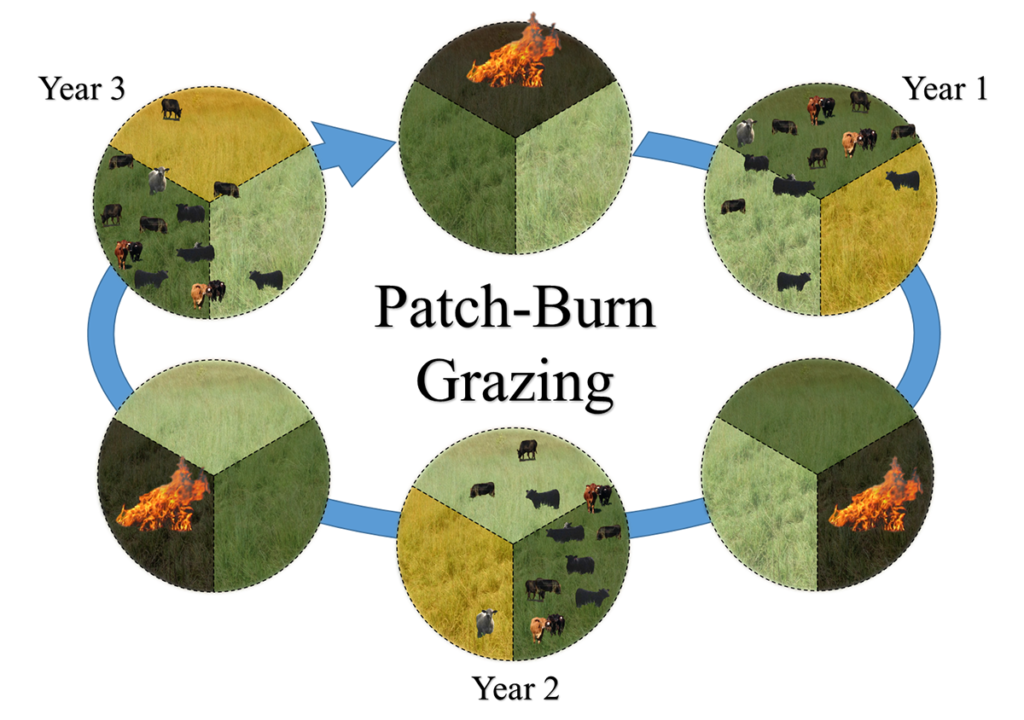
Schematic diagram of a three-patch system for patch-burn grazing. One patch is burned each spring, and cattle, which have access to all three patches, selectively graze patches burned most recently. The current year’s burn is grazed most heavily, the previous year’s with intermediate pressure, and the oldest (two years earlier) the least. Credit, A. Vander Yacht. 
Patch-burned native grass pasture. Fireline divides pasture into burned area (on right) and unburned area (on left). Cattle selectively graze the most recently burned area creating greater structural heterogeneity within the pasture.
Continuous Grazing of Mixed Native Warm-Season Grass in the Fescue Belt
Native grasses have often been characterized as being difficult to manage. The underlying concern is that they can be easily overgrazed and the stand quickly degraded. Therefore, rotational grazing has generally been recommended for managing native grass pastures. However, many stockmen in the Great Plains graze native grass rangelands all season long at set stocking rates. Because many producers may not want to follow strict rotational grazing guidelines, we wanted to explore how a minimal management approach could work for these grasses. Therefore, we initiated a study that examined two continuous grazing strategies, season-long, continuous grazing and a variation we called, “Heavy early.” The Heavy approach started the grazing season with 25% greater stocking than the simple continuous approach but, after late June, stocking was reduced to 25% below that of the simple continuous. This strategy was designed to more closely match the growth curves of native grasses, capture the spring flush and limit stress on the stand later in the summer.
After three summers we found that both approaches produced similar overall rates of gain for steers (2.06 lb per day), grazing days per acre (152 steer days), and total gain (317 lb per acre). More importantly though, we found that the sward vigor of the stands did not appear to be affected by the continuous grazing. At the conclusion of the study, tiller density (a reliable measure of stand vigor) was at 73 per sq foot indicating the stands had not been degraded. This despite an average of 105-day grazing season each summer and at least one severe drought (2016) during the study. Based on this work, it appears that managing native grass pastures can be quite simple and does not require precise rotational grazing or intensive management to be successful.
This study was supported by the University of Tennessee Foundation through the gift of a generous, anonymous donor and by the University of Tennessee Institute of Agriculture.

Steers grazing a mixed-species native grass pasture during late summer drought. This pasture has been continuously grazed (about 900 lb per acre initial stocking) from mid-May through late August for three summers in a row. This picture was taken after 99 days of grazing in August 2016. 
Continuous stocking (CONT) maintains a single, set stock density for the full season while heavy early (HEAVY) begins the summer grazing season with 125% of the stock density of CONT and then, after mid-summer, reduces that to 75% of CONT. HEAVY is intended to more closely match the productivity of the forages, which grow more rapidly early in the growing season.
Impact of Perennial Warm-Season Grass Forages on Profitability of Beef Cattle Operations in the Fescue Belt
Although a number of studies have evaluated net returns from summer grazing and cost of gain under specific grazing strategies, there are still no data on the impact of an integrated warm-season/cool-season forage model on overall enterprise profitability. Ideally, such an evaluation should be based on empirical data, from a field experiment examining such an integrated production model. Unfortunately, data from such experiments are lacking. Therefore, to gain some insight into what the economic impact of incorporating native grasses into tall fescue forage systems might have, we developed an economic model. The model takes into account pasture costs, calving rates, calf weaning weights, animal nutritional needs, hay feeding costs, weather variability (i.e., drought frequency and severity), and market prices for calves and cull cows. All data were based on either University of Tennessee Extension budgets, existing market data, and historical weather records. Incorporating variability for input data, net present value calculations were run with 5,000 iterations. Models included three scenarios, a 100% fescue system and two integrated systems each with 30% warm-season grass, one with bermudgrass and one with switchgrass. For all three forage systems, we included a simulation with fall- and spring-calving herds.
Based on this modeling exercise, cost of pastures was lowest for switchgrass and highest for bermudagrass, largely driven by input costs. Net present value, therefore, was always greatest for the switchgrass systems. For spring-calving herds, the bermudagrass system was also more profitable then the tall fescue only system. However, for fall-calving herds, the tall fescue only was more profitable than the bermudagrass system. While these results are based only on a model, and should be viewed cautiously, they do suggest that the incorporation of a low-cost, warm-season perennial such as switchgrass could make substantial contributions to enterprise profitability.
This research was supported by the University of Tennessee Foundation through the gift of a generous, anonymous donor and by the University of Tennessee Institute of Agriculture.

Average net present value of simulated 100-ac forage systems with both spring- and fall-calving beef cow-calf herds. Net present values were calculated using an assumed 10-year useful stand life. Forage systems consisted of 100% tall fescue (TF100), 70% tall fescue with 30% bermudagrass (BG30), and 70% tall fescue with 30% switchgrass (SG30). Vertical bars are ± 1 SE. K. Brazil, Univ. TN Dissertation. 
Annual net returns of spring-calving beef cow-calf herds grazing 100% fescue (Spring TF100), 30% bermudagrass/70% fescue (Spring BG30), and 30% switchgrass/70% fescue (Spring SG30) 100-ac forage systems across varying average annual rainfall (%) levels, with all other independent variables held constant at their means. Rainfall percentages were based on 70 years of data collected at Knoxville, TN. K. Brazil, Univ. TN Dissertation.
Using Nurse Crops During Establishment of Native Grass Forages
Native grasses can be challenging to establish. In addition, during the seedling year, use of stands for grazing or hay production is discouraged because of negative impacts on seedling development. Therefore, producers lose production for an entire year during the establishment process. One possible to solution to off-set this gap in production is to use a nurse crop during the establishment year. Planting a summer annual, but at a reduced density, could provide some competition to suppress weeds while also offering a forage crop.
We began exploring this by conducting a small plot experiment at the Plant Science Unit of the East Tennessee Research and Education Center. We drilled browntop millet at a full rate and half rate into recently planted stands of switchgrass and big bluestem. During the summer, we harvested the millet based on two criteria – when the millet was ready for hay harvest and when the native grass seedlings were being overtopped by the millet. Unfortunately, our timing on these harvests were hampered by work schedules and weather. As a result, the millet only ended up adding to the overall level of competition for the native grass seedlings.
Based on that first study, we have initiated a second study at the Greenacres Foundation in Ohio. In this second trial, we included an additional summer annual, a high diversity blend. In this project, we relied on grazing rather than mechanical removal of the summer annuals. During our first year, we wound up with a very similar problem, two much competition from the annuals as a result of our timing and intensity of grazing. As this project continues, we anticipate being able to adjust the grazing management to allow for a more favorable outcome. One thing appears to be obvious though. Trying to produce forage during the seedling year requires very good timing and implementation of canopy management treatments. There does not appear to be much room for error. This project will continue through 2021.
These studies were supported by a USDA Agriculture and Food Initiative grant and a grant from the Greenacres Foundation.

Heavy canopy of browntop millet and lack of weeds in plot at right (foreground), late June. By contrast, unplanted control plot (center foreground) has an abundant population of broadleaf and grassy weeds. Clipping millet (plot on left foreground) 44 days post-planting removed the heavy canopy, but not soon enough to maintain good native grass seedling populations. 
Post-grazing, high-diversity nurse crop, late summer 2019. Note big bluestem seedling in front of hand. Although many seedlings survived the heavy growth of the summer annual, populations were reduced by the end of the season vs. control plots.
Overseeding Winter Annuals into Native Grasses
Although native grasses can produce large amounts of high quality forage during summer, many producers may want to extend the grazing seasons on these fields during the fall and/or spring. The obvious solution is to overseed the stands with a winter annual forage crop. After all, this is a widely used practice with other warm-season perennials such as bermudagrass. An initial evaluation was conducted using three winter annuals – cereal rye, wheat, and annual ryegrass. The winter annuals were subjected to one of three harvest timings – April 15, May 1, or May 15. Although we expected the latter maturing annuals and later harvest dates to have an increasingly negative effect on switchgrass stand vigor and yields, that was not the case. In fact, there was no loss in stand vigor (as measured by tiller density) or in subsequent switchgrass yields.
Currently, we are wrapping up a grazing study in which existing switchgrass and big bluestem pastures have been overseeded with either cereal rye or a blend of rye, brassicas, and clovers. To date, it does not appear that the winter annuals have had any negative affect on the native grasses. However, we have also had some difficulty in getting strong stands of winter annuals due to late planting (first year of the experiment) and dry fall weather and/or exceptionally cold winters. This underscores the risk of relying on annual forage crops. This past fall, we got very good stands of annuals and some excellent grazing. Analysis of results will continue through 2020.
These projects were supported by grants from USDA Agriculture and Food Initiative and the USDA Cooperative State Research, Education, and Extension Service through Tennessee Hatch projects.

Overseeding winter annuals into lowland switchgrass for two consecutive years, regardless of harvest date (April 15, May 1, May 15), did not weaken the switchgrass or reduce biomass yields. Credit, D. McIntosh. 
Cattle grazing winter annuals overseeded into dormant native grass pastures, spring 2019. Note unplanted controls within each 3-acre experimental pasture. Credit, J. Richwine.
Northern Bobwhite Survival and Habitat Use in Native Grass Pastures in the Fescue Belt
Northern bobwhite populations have experienced long-term, severe population declines. Past conservation efforts have focused disproportionately on habitat outside of production agriculture, on idled acres. A good example of this approach has been the Conservation Reserve Program (CRP), which takes land out of production. An alternative approach, one that could potentially impact many more acres, is a working lands model. Such a model focuses not on removing land from production, but rather on how to produce agricultural commodities and conservation benefit from the same land. One example of that is forage production using native grasses. Research has shown these grasses produce large volumes of loc-cost, high quality forage. What is less clear though, is how grassland wildlife species such as the northern bobwhite fare in when native grasses are subjected to grazing. Although studies in rangeland in the Great Plains suggest that such a combination is a “win-win”, very little data exists for eastern grasslands, such as those in the Tall Fescue Belt.
Beginning in 2019, we initiated a study, the first of its kind east of the Mississippi, to evaluate bobwhite populations within grazed native grass systems. This radio telemetry study is examining habitat selection, nest survival, and adult survival throughout the year on the Blue Grass Army Depot in Kentucky. Although hampered by a small sample size, a result of a very small population (unfortunately, the norm in the Tall Fescue Belt in recent years), some interesting data is emerging. With no specific accommodation of bobwhite in the grazing regime, these birds are readily using, nesting in, and surviving in native grass pastures. By contrast, use of surrounding tall fescue pastures is very limited. The project is scheduled to continue through 2021. Populations of grassland passerines are also being monitored as a part of this study.
Support for this research is being provided by a grant from the USDA, Natural Resources Conservation Service’s Working Lands for Wildlife Program, the Kentucky Department of Fish and Wildlife Resources, and the University of Tennessee Institute of Agriculture.

Locations of radio-telemetered northern bobwhite and nests overlaid on a study area map indicating actively grazed native grass pastures. Bobwhite are using these pastures routinely, but have avoided cool-season grass pastures (right side of image). Areas of high use just to the west of the native grass pastures are weedy fields that were in the process of conversion to native grasses. Credit, D. Mitchell. 
Grazed native grass pasture in late summer showing excellent structural diversity. 
By contrast, an adjacent stand of native grasses that has not been grazed, is rank and has limited structural diversity. Quail readily use grazed native grasses, but less commonly the thick, ungrazed stands.
Density and Nest Success of Grasshopper Sparrow and Field Sparrow on Continuously Grazed Native Warm-Season Grass Pastures
There is a lack of data on grassland bird response to grazing in native grass pastures. Given the potential benefits of a working lands conservation model for conservation of these at-risk species, understanding their response is critical. Therefore, we initiated a study on eight 20-acre native grass pastures in east Tennessee. All pastures were subjected to continuous, season long grazing (105-day duration) with one of two treatments: a standard stocking rate, and one that increased stocking by approximately 20% prior to late June, and then reduced that rate to 20% below the standard during late summer.
In addition, we monitored these same species on four reference tall fescue pastures of the same size and located in the same vicinity. Based on data collected over three summers, we learned that these species selected for the native grass pastures over tall fescue.
Although nest success and productivity were not different among the pasture treatments, the greater number of nests in the native grass pastures resulted greater overall productivity. Grasshopper produced 2 or 6 times and field sparrows 3 or 6 times more fledglings per acre compared with tall fescue pastures. The greater increases were associated with grazing management that maintained more optimum canopy heights – the standard stocking rate (about 900-1,00 lb per acre). Nest loss due to trampling was minimal. This study reinforces the idea that grazed native grasses are compatible with successful conservation of at-risk grassland birds.
This project was supported by the University of Tennessee Foundation through the gift of a generous, anonymous donor, the Tennessee Wildlife Resources Agency, and the University of Tennessee Institute of Agriculture.

Cattle grazing a native grass pasture during a season-long, continuous grazing study conducted in Tennessee. Cattle grazed pastures for approximately 110 days each summer, from mid-May to late August. Credit, K. Brazil. 
Grasshopper sparrow (top) and field sparrow (bottom) selected for native grass pastures grazed continuously, selected in proportion to availability for native grass pastures grazed with a heavy early treatment, and selected against tall fescue pastures for nest placement. K. Brazil, Univ. TN Dissertation.
Enhanced Biodiversity within Native Grass Pastures
Increased interest in soil health, wildlife conservation, and continuing declines in pollinator populations have all drawn attention to enhanced biodiversity within forage systems. Work on – and guidance for – improved plant diversity within native grass pastures has been limited. Information is needed to determine which native forbs and legumes can be successfully established within pasture systems, which will persist, not become pests, produce flowers that will benefit pollinators, and contribute to cattle forage production.
To address these questions, we initiated a study at the University of Tennessee’s Research and Education Center at Greeneville. Two pastures, composed of lowland switchgrass and the second a big bluestem indiangrass blend, were overseeded with a 12-species blend of native forbs and legumes. The pastures were then sub-divided into 20 paddocks each and assigned to one of 5 grazing treatments. These treatments include no rest (grazed all season), no grazing (control) and another three with rest periods early, mid, and late season.
We used this approach rather than adjusting stocking rates because experience has shown us that under light stocking rates, natives can easily become over-mature and thus limit forage quality and pasture productivity. Too, these treatments, in effect, mimic a rotational system in terms of the timing of rest intervals. Data continues to be collected on this study. Completion will be in fall of 2022.
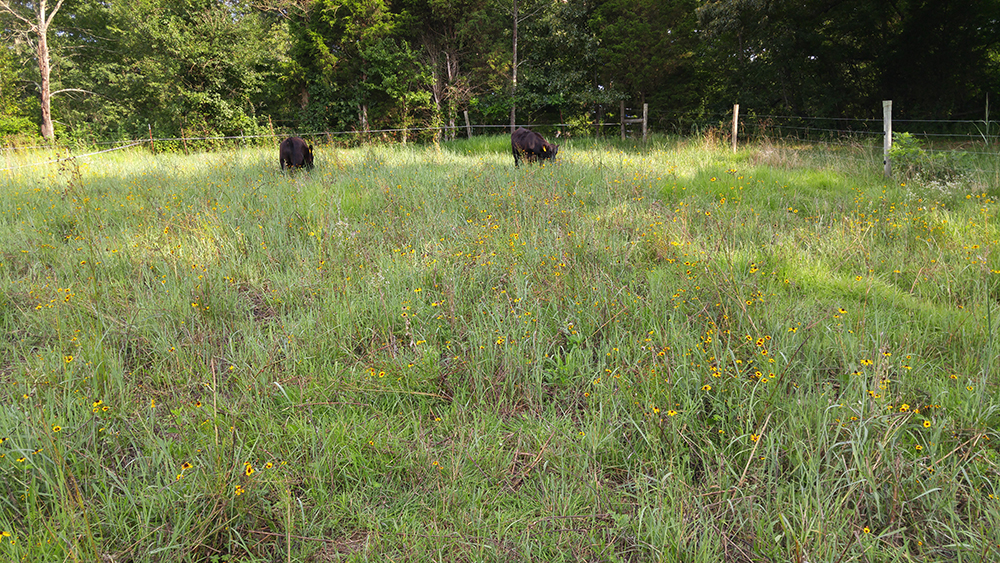
Steers grazing a switchgrass pasture overseeded with a 12-species blend of native forbs and legumes. The study is examining how well these species establish, grow, and persist in native grass pastures and whether cattle graze them or not.
Native Forb and Legume “Variety Trial”
A companion project to the pasture study mentioned above, this study is evaluating yield, persistence, flowering phenology, and forage nutritive qualities of 14 native species. Such baseline data will be helpful in understanding how to best integrate native forbs into forage production systems. Harvesting will begin in 2020 and is planned to continue for three summers. Species include coreopsis, prairie clover, Illinois bundle flower, partridge pea, sunflowers, black-eyed Susan, and cone flowers, among others.
These two projects are being supported by the University of Tennessee Foundation through the gift of a generous, anonymous donor, a grant from the Greenacres Foundation, a grant from the USDA, Natural Resources Conservation Service, and the USDA Cooperative State Research, Education, and Extension Service through Tennessee Hatch projects.

Research plots established to evaluate forage yield, persistence, and forage nutritive values of 12 native forbs and legumes. Oxeye sunflower (yellow), lance-leaf coreopsis (beginning to senesce), purple coneflower, and black-eyed Susan are all apparent in the first row of plots. Credit, K. Swilling.
Biodiversity, Soil Health, and Sustainability in Native Grasslands
Native grasses produce an abundance of forage but seem to do so with only modest fertility levels. What is the mechanism that allows for this unexpected productivity? Some possible explanations include symbiotic relationships with free-living soil microbes that fix nitrogen and mycorrhizae that supply phosphorous to the plants. Another alternative is mineralization – the decomposition of the abundant below-ground biomass produced by the prodigious roots of these grasses. Related to this last point is the role of invertebrates in shredding the biomass, initiating the process by which the decomposition begins.
To further explore these possibilities, a study was initiated to examine soil microbe communities, mycorrhizae root colonization, and invertebrate populations associated with native grass stands.
The native grasses have been subjected to varying levels of N and P fertilization (at higher levels, these may suppress soil microbes and mycorrhizae, respectively), hay harvest regimes, and grazing. Furthermore, the pastures have been treated with either a simple (cereal rye) or complex (rye, brassicas, clovers) overseeding or left as an unplanted control. Analyses are underway as field work for this project concludes in 2020.
This work has been supported by a grant from the USDA’s Agriculture and Food Initiative and by the University of Tennessee Institute of Agriculture.

Students collecting soil samples to evaluate free-living soil microbial communities. Many of these microbes play critical roles in N-cycling and may explain the low N-demand for switchgrass and other native grasses. Credit, J. DeBruyn. 
Microscopic image of switchgrass root showing hyphae (thin blue lines) and vesicles (larger blue area at terminus of hyphae) associated with mycorrhizal colonization of roots. Such associations may be important for phosphorous uptake by switchgrass plants. Credit, D. Butler.
Avian Ecology During Oak Savanna and Woodland Restoration
Woodlands and savannahs once were prevalent across much of the eastern United States. Like many other native grassland communities however, they have been almost completely eliminated and are now considered one of the most imperiled communities in the US. Associated wildlife species such as prairie warbler and red-headed woodpecker are also of high conservation concern. We conducted research over a 10-year period that included monitoring of bird populations. Analyses included occupancy, abundance, and for two species, prairie warbler and red-headed woodpecker, nest success.
Results demonstrated that occupancy was strongly influenced by live basal area for many species. However, percent herbaceous ground cover appeared to be an even stronger indicator of occupancy. Interestingly, across the range of basal area and herbaceous groundcover we evaluated, presence of early successional species increased markedly, while that for late-successional species declined only moderately. Thus, the bird community experienced overall increased the presence of at-risk species without substantial decrease in late successional species, many of which were not of high conservation priority.
Indeed, analysis of abundance, when factored by Partners in Flight conservation priority scores indicated that stands undergoing restoration provided much greater conservation benefit than the closed-canopy stands. Nest success for red-headed woodpecker was quite high (>80% survival). Prairie warbler nest survival was variable with much lower rates the year of a prescribed burn and higher rates one year-post burning. Notably, no nest of either species was found in our undisturbed control stands. Woodland and savannah restoration could be a valuable tool to not only restore a rare community, but could also contribute to improved conservation of many early successional bird species.
This research was supported by grants from the USDI’s Joint Fire Science Program, North Carolina Wildlife Resources Commission, the National Wild Turkey Federation, Tennessee Wildlife Resources Agency, and the University of Tennessee Institute of Agriculture.

Restored savannah showing diverse understory of grasses, forbs, and woody species. As is typical of savannahs, the overstory, although much reduced, is still present but the midstory has been largely eliminated. Credit, C. Coffey. 
Red-headed woodpecker feeding a fledgling on top of a sang in a restored savannah. Savannahs provide excellent habitat for this at-risk species. Credit, S. McIntire.
Assessment of Wildlife Sustainability in Switchgrass Biofuel Feedstock Production
Prospects for large-scale biomass feedstock based on dedicated herbaceous crops such as switchgrass led to questions about how it would impact wildlife. Several years ago, the Department of Energy had forecast that as many as 35 million acres of such crops may be required to meet congressionally mandated energy targets. At that scale, implications of land conversion for breeding grassland birds, many of which are already considered at risk, could be substantial. We conducted a research project that monitored breeding bird occupancy and nest success over two summers at three locations. At each location (east Tennessee, northwest Pennsylvania, and western Kansas), we identified 10 production fields and 10 “matrix” fields. The matrix fields represented the prevailing land use for the site that would be most likely to be converted to energy crops. For Tennessee, these were tall fescue pastures, for Pennsylvania, cool-season pastures, and for Kansas, Conservation Reserve Program fields. We also collected data on use of the fields by pollinators, principally native bee species.
While analysis for these data sets is still being finalized, preliminary results for the bird occupancy suggest that responses varied by species. Red-winged blackbird, common yellowthroat, and dickcissel seemed to prefer the switchgrass, northern bobwhite, indigo bunting, and field sparrow appeared to use them equally, while meadowlark and grasshopper sparrow had greater occupancy in matrix fields. Results varied by location with landscape factors influencing occupancy. We continue to evaluate these data and are developing a spatially-explicit landscape model that can be used for evaluating biomass scenarios and their likely effect on many of these bird species.
This research was supported by a USDA Agriculture and Food Initiative grant.
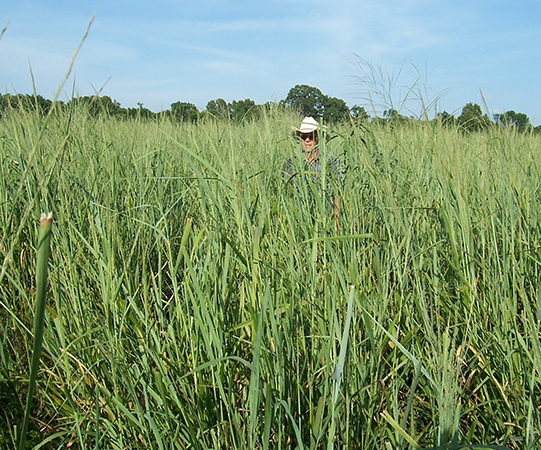
Switchgrass is a robust plant with low input requirements that produces high volumes of biomass while increasing soil organic matter. 
Among the species documented to use switchgrass for nesting were northern bobwhite, a species that has experienced over 50 years of population decline. Credit, J. Richwine
Potential of Eastern Military Bases for Conservation of Grassland Bird
Building Partnerships for Regional Grassland Bird Conservation in the Southeastern US Department of Defense Legacy Resources Project 05-105
Native grasslands are one of the most endangered ecosystems in the eastern United States. The grassland bird species that are supported by these grasslands are also in dire need of conservation attention because of declining populations. Military installations provide important grassland habitat that serves a vital function for military training. As a result, eastern military installations have the opportunity to provide a critical role in conservation of grasslands and grassland bird communities.
Project Goals:
- Document the potential of eastern military bases for grassland bird conservation
- Document the status of grassland birds on one focal military installation (Fort Campbell)
- Foster the development of regional partnerships for grassland bird conservation


